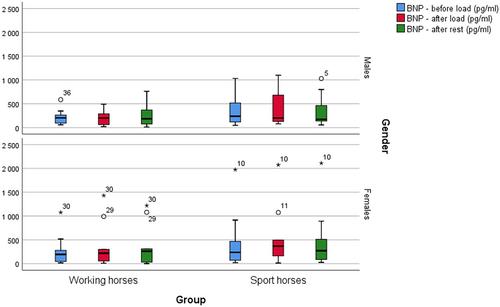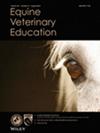The impact of different types of exercises on echocardiographic parameters and plasma BNP concentrations in working and sports horses
Abstract
Background
Brain natriuretic peptide (BNP) serves as a crucial cardiac biomarker in human and small animal veterinary medicine, yet its role in equine cardiology remains underexplored.
Objectives
This study aimed to investigate the influence of different exercise types on BNP concentrations and single brief echocardiographic parameters in two distinct horse populations, while also examining potential correlations between BNP concentrations and echocardiographic variables.
Study design
Forty clinically healthy horses, categorised into working and sports groups, underwent exercise testing exercise to their purposes. BNP concentrations were measured using a horse-specific ELISA kit, and brief echocardiographic examinations were conducted 24 h post-exercise.
Methods
Blood samples were collected before, after exercises, and at rest to determine plasma BNP concentrations. The brief echocardiographic examinations looked only at M-mode imaging from the right parasternal window, and assessed cardiac chambers and ventricular diameters. BNP concentrations and echocardiographic variables were compared between the two groups.
Results
Exercise did not significantly increase BNP concentrations in either group, with sports horses exhibiting higher basal BNP values (18.0–1973.0 pg/mL) compared to work horses (14.4–1074.5 pg/mL). No significant differences in BNP concentrations were observed between breeds, sexes, or pregnancy statuses. Brief echocardiographic examinations using M-mode imaging from the right parasternal window revealed significant differences in right ventricular dimensions in diastole and relative wall thickness between the groups. A low negative correlation (r = −0.329, p = 0.038) was observed between BNP concentration and fractional shortening.
Main limitations
Single pre-exercise blood sampling, brief M-mode echocardiography, and lack of exercise standardisation in the endurance horse group limited assessing high biological variability on BNP concentration and echocardiographic parameters in the tested horses.
Conclusions
Assessing BNP concentrations and echocardiographic parameters during different exercises can be helpful in examining the functional status of the equine cardiovascular system, guiding tailored exercise regimens for optimal equine well-being.





 求助内容:
求助内容: 应助结果提醒方式:
应助结果提醒方式:


